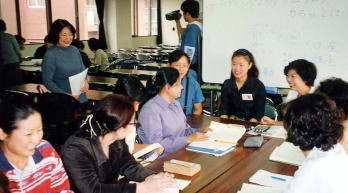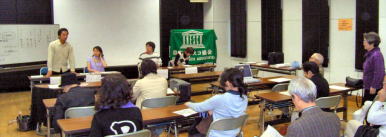
No.213-3
 |
Last year, when the Meguro UNESCO Association made a new start, various reforms were made in the Japanese language course. The year proved to be fruitful in that we were able to deepen mutual understanding between Japanese language education committee members and non-members who met to discuss how to achieve the makeover.
Thanks to your cooperation, the total number of people attending the classes last year exceeded 400, which keeps us busy now. As students are staying in Japan longer, more people hope to study intermediate, and advanced classes after finishing beginner’s classes. Some would like to study Kanji characters. I am very pleased to see them actively participate in other Meguro UNESCO programs such as international exchange activities and education for international understanding for elementary school students.
The new situation has brought us a new challenge. The lesson content and textbooks should be reviewed to make them suitable for Meguro UNESCO Japanese language classes. We volunteers, with the UNESCO spirit of “living together” in mind, would like to do our best to make our classes responsive to the needs of the participants.
Field Report on the Terakoya Projects in India and Nepal
 |
UNESCO Lecture - Nov. 20, Sat.14:00~ Nakameguro Seishounen Plaza
The Youth Activity Committee members of the Meguro UNESCO Association who took part in the ‘Study Tour’ gave a field-report symposium. The Study Tour is held annually by the National Federation of UNESCO Associations in Japan (the NFUAJ) targeting youths from all over Japan. Four members (Miss Nozomi Imahata visiting India in 2003; Mr. Takeshi Kusuhara visiting India in 2004; Mr. Hiroshi Toyama and Miss Mieko Morita visiting Nepal in 2003) were the panelists. They made the symposium lively with activities that included sharing their findings through a quiz and wearing folk costume they bought in the visiting country. Their presentations provoked various questions and comments from the audience.
Dr. Tajima, an adviser to the Meguro UNESCO Association, explained the difference between the educational situation of Japan and that of developing countries, based on his long working experience of supporting developing countries. In summary he said that as ‘Terakoya’, learning places for common people, spread in Japan, basic education has prevailed for a long time the whole nation. However, it is commonly seen in developing countries that education is available only for some leading people (those at the top of the pile), and basic education for the common people lags behind. Therefore it is very meaningful to proceed in popularising ‘Terakoya’, with the NFUAJ gathering power of local associations and utilizing the funds of ODA.